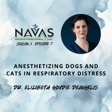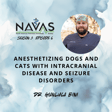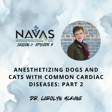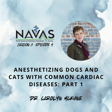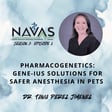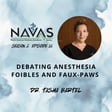
Dr. Sheliah Robertson on Anesthesia for Senior Dogs and Cats
Welcome to another episode of the NAVAS podcast! How many times in your career, after recommending a surgical or dental procedure for a dog or cat, have you been asked whether a beloved aging pet was too old to be anesthetized? Today, we’re diving into a topic that many veterinary professionals encounter but may not always feel fully prepared for: anesthesia for senior dogs and cats. Older pets can present unique challenges when it comes to sedation and general anesthesia, and understanding how aging impacts their physiology is key to providing safe and effective care.
In this episode, we have the honor of speaking with Dr. Sheliah Robertson, a veterinary anesthesiologist who is also board-certified in animal welfare and the senior medical director at Lap of Love, a network of veterinary at-home euthanasia and hospice care providers. Dr. Robertson brings a wealth of experience and insight into the world of anesthesia for geriatric pets. We’ll be discussing everything from anesthetic risks and frailty in older animals to how aging affects vital organ function and what that means for anesthesia protocols. This conversation is guaranteed to be packed with valuable information to enhance your understanding and improve outcomes for your older patients.
Resources mentioned in this episode:
Dr. Sheliah Robertson’s work at Lap of Love
The ERAS Society (Enhanced Recovery After Surgery)
Development of ERAS protocols for veterinary medicine
A review article on improving postoperative sleep
Research on the effect of preoperative melatonin on the propofol dose required to induce anesthesia in dogs
An article on how pre-surgery rehabilitation effects surgical outcomes in aged patients
If you like what you hear, we have a couple of favors to ask of you:
Become a member of NAVAS for access to more anesthesia and analgesia educational and RACE-approved CE content.
Spread the word. Share our podcast on your socials or a discussion forum. That would really help us achieve our mission: Reduce mortality and morbidity in veterinary patients undergoing sedation, anesthesia, and analgesia through high-quality, peer-reviewed education.
As a reminder, the ACVAA Annual Meeting is happening in Denver, CO from September 25-27 later this year. Registration rates are discounted for NAVAS members. We hope to see you there! Sign up today!
Thank you to our sponsor, Dechra - learn more about the pharmaceutical products Dechra has to offer veterinary professionals, such as Zenalpha.
If you have questions about this episode or want to suggest topics for future episodes, reach out to the producers at education@mynavas.org.
All opinions stated by the host and their guests are theirs alone and do not represent the thoughts or opinions of any corporation, university, or other business or governmental entity.
